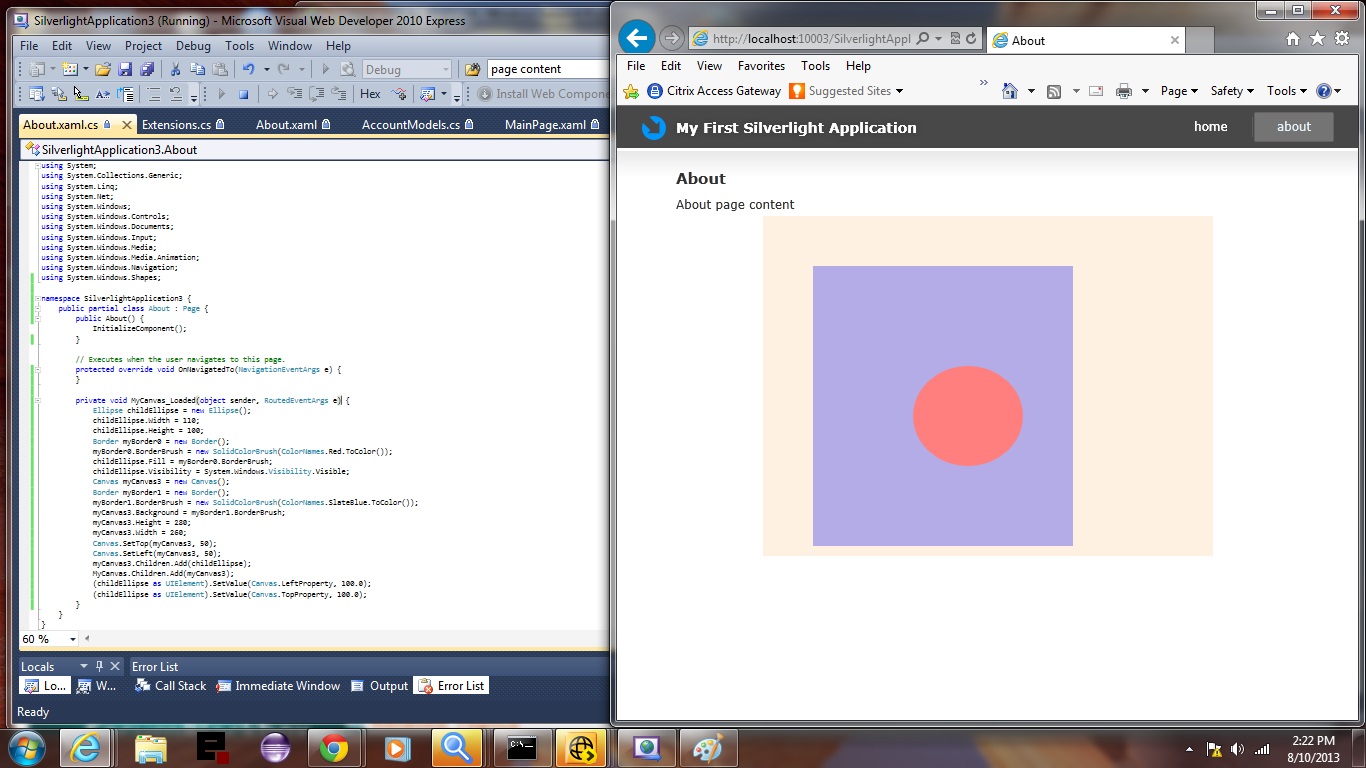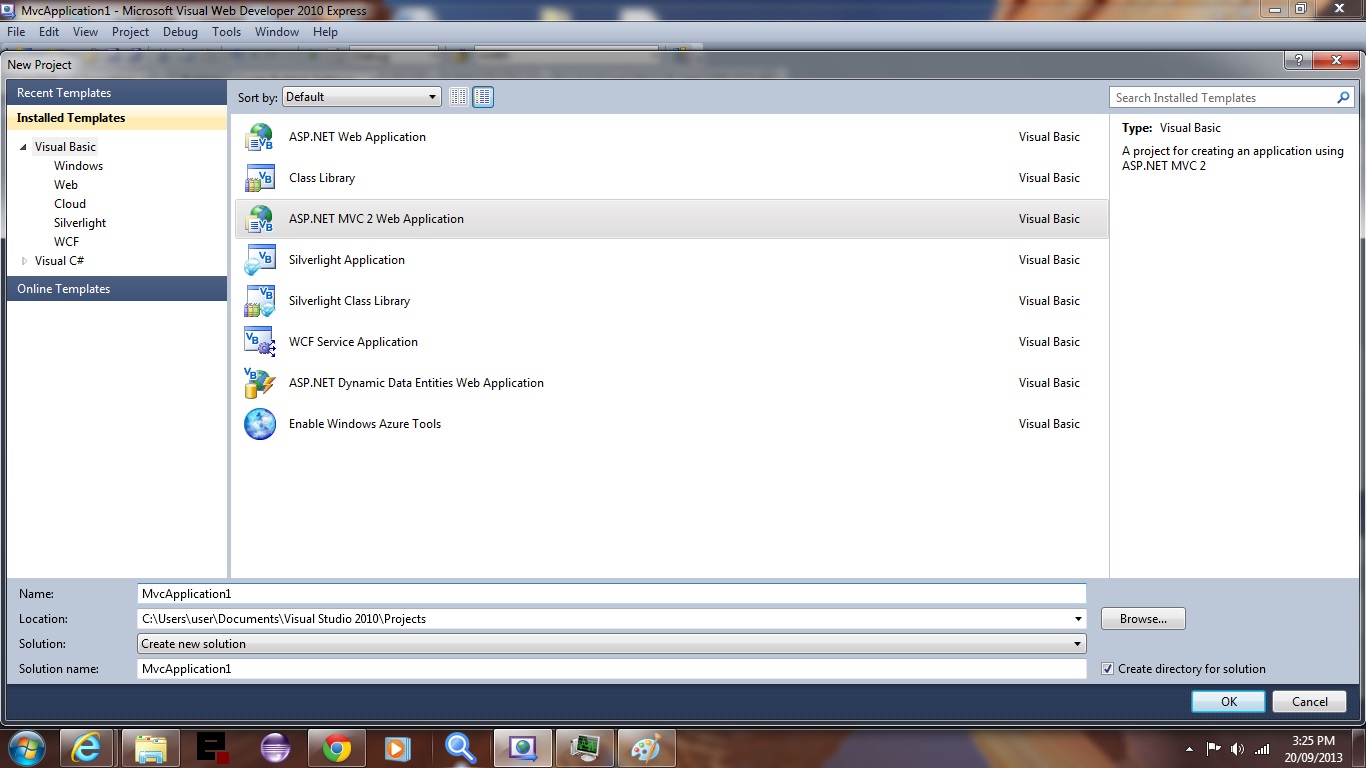Today’s tutorial creates a Silverlight Navigation MVC Application website in ASP.Net with Microsoft Visual Studio (2010 Express) building on the knowledge of the previous ASP.Net MVC Primer Tutorial. MVC stands for Model/View/Controller web design architecture methodology. Even if you lack skills in the M[odel] bit of this software technique (and the experts recommend a “fat” M[odel] element to your design … guess we should be asking you know who, perhaps?) Let’s see what Wikipedia says about MVC below.
Model–view–controller (MVC) is a software architecture pattern which separates the representation of information from the user’s interaction with it.[1][2] The model consists of application data, business rules, logic, and functions. A view can be any output representation of data, such as a chart or a diagram. Multiple views of the same data are possible, such as a bar chart for management and a tabular view for accountants. The controller mediates input, converting it to commands for the model or view.[3]
In the meantime enjoy this tutorial showing you the great MVC methodology for the creation of Silverlight Navigation ASP.Net Application website using Microsoft Visual Studio (Express). You’ll notice that the Microsoft Visual Studio 2010 Express needed to have Service Pack 1 (SP1) applied to it to get the ball(s) rolling … please do not stand in the middle of a tenpin bowling alley examining this too closely … too many developers have suffered this fate … and it needs stamping out. You may also notice the use of Silverlight’s canvas element which we may revisit in the future for Silverlight and maybe HTML5 and maybe Tcl/TK.
Downloadable Silverlight ASP.Net (C#) Controller programming source code here for HomeController.cs after changes and HomeController.cs before changes (for your comparison).
Downloadable Silverlight ASP.Net (C#) Model programming source code here for AccountModels.cs
Downloadable Silverlight ASP.Net (C#) class programming source code here for Extensions.cs as created for this tutorial to cater for Brushes object that used to be in System.Drawing before Silverlight thanks to this great link.
Downloadable Silverlight ASP.Net configuration file here for Web.config
Downloadable Silverlight ASP.Net Content programming CSS code here for Site.css
Downloadable Silverlight ASP.Net Content Master Page source code here for Site.Master
Downloadable Silverlight ASP.Net View Page source code here for Home.xaml after changes and Home.xaml before changes (for your comparison).
Downloadable Silverlight ASP.Net View Page source code here for About.xaml after changes and About.xaml before changes (for your comparison).
Downloadable Silverlight ASP.Net View Page source code here for App.xaml
Downloadable Silverlight ASP.Net View Page source code here for MainPage.xaml
Downloadable Silverlight ASP.Net (C# code below) View Page source code here for Home.xaml.cs after changes and Home.xaml.cs before changes (for your comparison).
Downloadable Silverlight ASP.Net (C# code below) View Page source code here for About.xaml.cs after changes and About.xaml.cs before changes (for your comparison).
Downloadable Silverlight ASP.Net (C# code below) View Page source code here for App.xaml.cs
Downloadable Silverlight ASP.Net (C# code below) View Page source code here for MainPage.xaml.cs
Link to Silverlight information from Wikipedia.
Link to MVC information from Wikipedia (as per quote above).
Will (almost) leave you with good Microsoft link about Silverlight.
Will leave you with good Microsoft link about MVC.
Previous ASP.Net MVC Primer Tutorial is shown below.
Today’s tutorial creates an MVC website in ASP.Net with Microsoft Visual Studio (2010 Express). MVC stands for Model/View/Controller web design architecture methodology. Even if you lack skills in the M[odel] bit of this software technique (and the experts recommend a “fat” M[odel] element to your design … guess we should be asking you know who, perhaps?) MVC can be great for ASP.Net projects involving websites involving users who log in (ie. membership websites), where you can have the whole registration/forgot-password/remember-me/log-in/log-out methods coded in seconds. Let’s see what Wikipedia says about MVC below.
Model–view–controller (MVC) is a software architecture pattern which separates the representation of information from the user’s interaction with it.[1][2] The model consists of application data, business rules, logic, and functions. A view can be any output representation of data, such as a chart or a diagram. Multiple views of the same data are possible, such as a bar chart for management and a tabular view for accountants. The controller mediates input, converting it to commands for the model or view.[3]
In the meantime enjoy this tutorial showing you the great MVC methodology for the creation of ASP.Net websites using Microsoft Visual Studio (Express).
Downloadable ASP.Net (VB.Net) Controller programming source code here for HomeController.vb after changes and HomeController.vb before changes (for your comparison).
Downloadable ASP.Net configuration file here for Web.config after changes and Web.config before changes (for your comparison).
Downloadable ASP.Net Content programming CSS code here for Site.css after changes and Site.css before changes (for your comparison).
Downloadable ASP.Net Content Master Page source code here for Site.Master after changes and Site.Master before changes (for your comparison).
Downloadable ASP.Net View Page source code here for Index.aspx after changes and Index.aspx before changes (for your comparison).
Downloadable ASP.Net View Page source code here for About.aspx after changes and About.aspx before changes (for your comparison).
Downloadable ASP.Net View Page source code here for Contact.aspx as created for this tutorial (via copy and amend method).
Downloadable ASP.Net View Page source code here for Service.aspx as created for this tutorial (via add new View method 1 of 2).
Downloadable ASP.Net View Page source code here for News.aspx as created for this tutorial (via copy and amend method).
Downloadable ASP.Net View Page source code here for Guestbook.aspx as created for this tutorial (via add new View method 2 of 2).
Downloadable ASP.Net View Page source code here for Links.aspx as created for this tutorial (via copy and amend method).
Link to MVC information from Wikipedia (as per quote above).
Will leave you with good Microsoft link about MVC.
If this was interesting you may be interested in this too.
If this was interesting you may be interested in this too.




